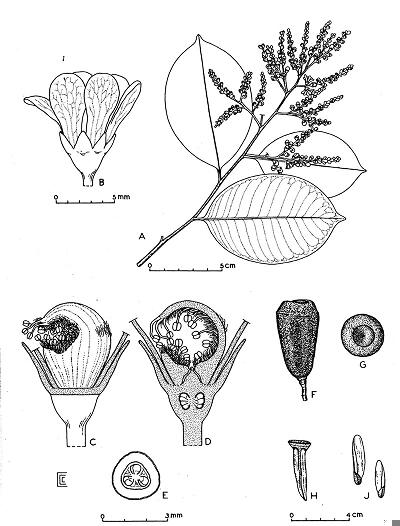Lecythidaceae
Cariniana Casar.

Kingdom: Plantae Rank: Genus Parent: Lecythidaceae Status: Valid
Common Names:
- Cachimbo, papelillo. - Spanish, Peru
Taxonomic Classification
Classification: Species of Cariniana have either actinomorphic or zygomorphic flowers. In the Los Amigos flora, C. decandra has actinomorphic flowers and C. domestica has zygomorphic flowers.
Morphological Description
Diagnosis: Flowers < l.5 cm diam.; ovary 3-locular; seeds with a unilateral wing; embryo with 2 leaf-like cotyledons.
Vegetative Morphology
Leaves: Leaves distichous, at ends of slender twigs (<5 mm diameter); venation brochidodromous or eucamptrodromous, the tertiary veins reticulate or percurrent.
Stipules: Stipules absent.
Exudate: Exudate absent.
Reproductive Morphology
Flowers: Flowers zygomorphic or actinomorphic, 1-1.5 cm diam., calyx not enclosed in bud, with 5 or 6 calyx-lobes; petals 5 or 6; flat or hooked at apices; androecium without hood, the stamens 10 to 150 on rim of staminal tube or inserted inside staminal tube, without fodder pollen, the anthers <2 mm long, with lateral dehiscence; ovary 3-locular, the style erect.
Fruit: Fruits dehiscent, cylindrical or campanulate, the opercular opening larger in diam. than diam. of seeds.
Seeds: Seeds round in cross section, not embedded in pulp, without aril or sarcotesta, with unilateral wing, the testa glabrous, not boney; embryo with leaf-like cotyledons.
Other
Uses: Yielding valuable timber.
Distribution: Sixteen spp. Northwestern Colombia, Amazonia Venezuela, Peru, Bolivia, Brasil, planalto of Brazil, and eastern Brazil and Paraguay.
Ecology: Mostly found in terra firme forests.